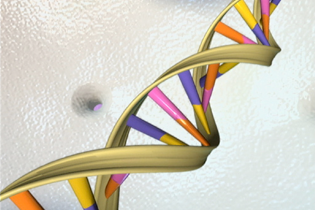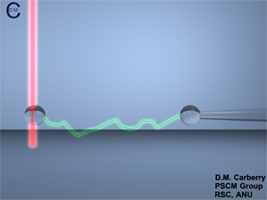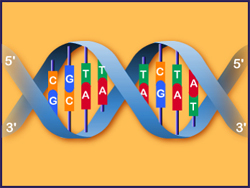
So, I take a cell out of you and crack it open (don’t worry you have many billions left and you shed like millions of cells a day from your skin) and take out your DNA. Somehow I stretch it out like you might pull on two ends of a piece of spaghetti. How long is that piece of DNA? A nanometer? A centimeter? How about a meter? Really? Yup.
DNA is really thin, about two nanometers across and cells can fold and pack DNA into a cell which is about ten micrometers across. DNA also doesn’t like to be stretched out and would rather fold up. We know something about DNA folding up, the double helix is formed because of the angle of the bonds that hold DNA together.
Nanotechnology is all about using tools to manipulate things at the nanometer scale. Imagine you are a scientist and you want to try stretching out a piece of DNA to study it. Think you could take a piece of DNA and stretch it out like a piece of spaghetti? Well you could. Scientists have stretched out DNA by attaching small beads to the end and then tugging on the beads using an optical trap. An optical trap is a powerful focused beam of light that can catch a bead and hold in place. You can even measure the f orce that it takes to stretch a piece of DNA. Shut off the optical trap and the DNA folds up again. It takes energy to stretch out a piece of DNA.
orce that it takes to stretch a piece of DNA. Shut off the optical trap and the DNA folds up again. It takes energy to stretch out a piece of DNA.
Scientists have even used DNA to build things and have even made things that move. To make DNA that can move from one place to another you need to design the DNA sequence so that it grabs on to one strand of DNA and then another. DNA is made up of four different bases, A, T, G and C. These bases bind to each other, A binds to T and G binds to C. So if you design your DNA it will be kind of like climbing hand over hand on a set of monkey bars, except these walkers are only a few nanometers in size.
To make DNA that can move from one place to another you need to design the DNA sequence so that it grabs on to one strand of DNA and then another. DNA is made up of four different bases, A, T, G and C. These bases bind to each other, A binds to T and G binds to C. So if you design your DNA it will be kind of like climbing hand over hand on a set of monkey bars, except these walkers are only a few nanometers in size.
Image Source: Polymers and Soft Condensed Matter Group | Genetics Primer
